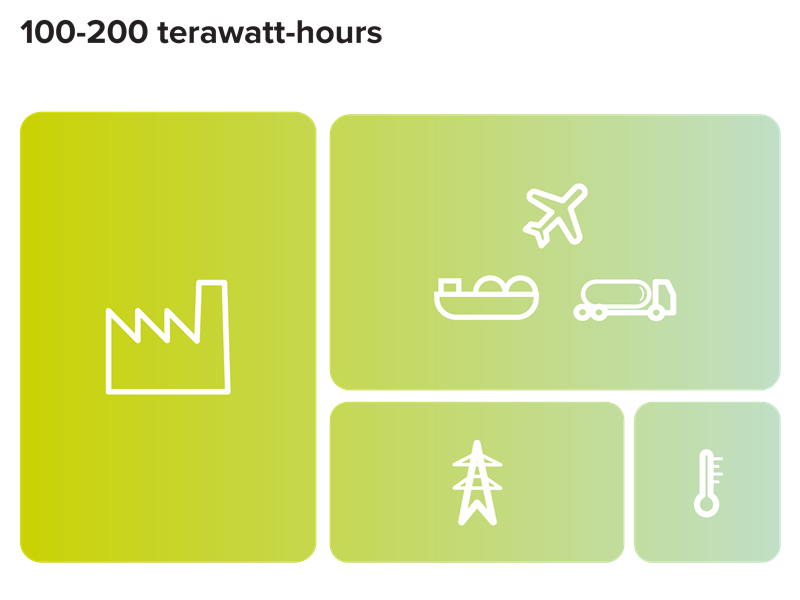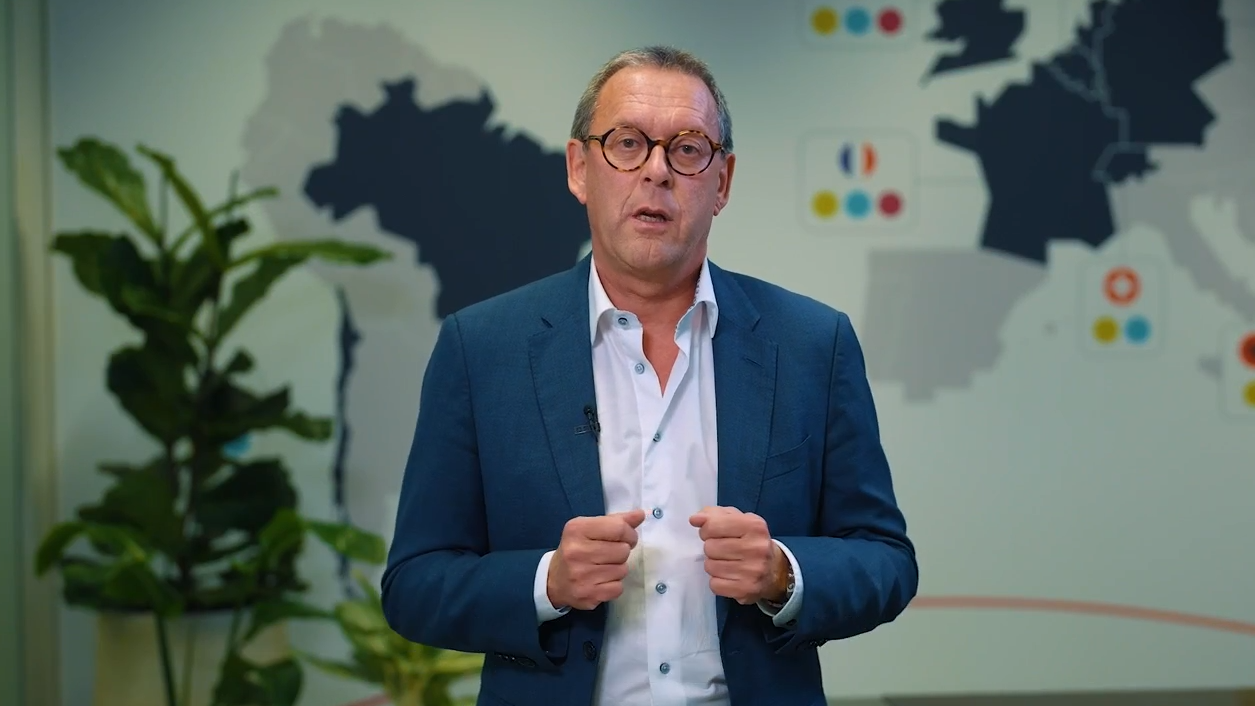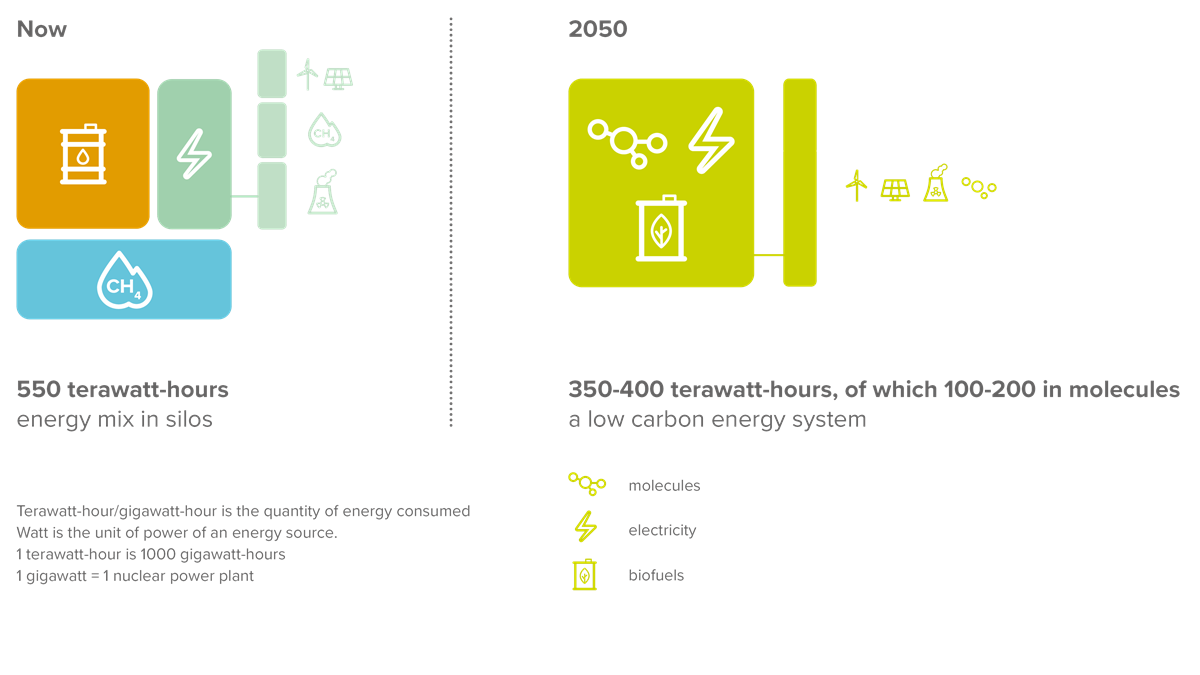

Energy anytime, anywhere. Green and low-carbon. With one energy system.
The energy landscape is being transformed. What does this mean for our citizens, our industry and our society?
The European supply crisis has made it crystal clear: Belgium and Europe must take urgent action to achieve a low-carbon, reliable and affordable energy system. Natural gas, electricity and oil currently account for a large proportion of the energy mix in Belgium's total annual consumption of 550 terawatt-hours. By 2050, consumption by Belgian households and businesses is expected to drop to 350-400 terawatt-hours. Furthermore, by 2050 our energy mix will be a combination of electrons, molecules and biofuels.
A low-carbon energy mix is possible. A low-carbon integrated energy mix is better. An integrated long-term approach in which expected energy consumption is linked to an optimised energy mix with the aim of achieving carbon neutrality. Optimising the entire chain (production, transport, storage, consumption) in terms of costs and implementation times, while maintaining security of supply. An integrated vision right from the start.
Crucial role for green and low-carbon molecules
-
raw material for industry
-
fuel for industry
-
fuel for long-distance transport

-
fuel for power stations
-
heating sources for buildings
How much demand will there be for green and low-carbon gases by 2050?

Carbon capture is part of the solution

A solution for significantly decarbonising our industry
In a climate-neutral energy system, carbon capture will be part of the equation. In sectors like the cement and lime industries, significant amounts of CO₂ are inevitably released via chemical reactions during the production process itself. CO₂ capture is the only option if those sectors are to sustainably maintain their activity and employment. CO₂ capture is an alternative for industrial processes that require high temperatures in those cases where, for example, electricity does not currently offer an alternative. With infrastructure to transport captured CO₂ industry has a way to direct CO₂ to safe storage locations or to companies that reuse CO₂ as a raw material.
Need for carbon infrastructure
In the system model, Fluxys considers CO₂ extraction technologies to offset remaining emissions. With annual emissions of 100 million tonnes of CO₂ in Belgium, our highly industrial character (responsible for 40 million tonnes of CO₂ per year) and the presence of an active process industry, carbon capture is an efficient way of reducing CO₂ emissions. Having infrastructure for carbon capture, transport and storage in place makes a great deal of sense. It is one way of securing our industry and preserving the workforce in Belgium.


The bottlenecks of our sustainable energy supply
Bottleneck 1
Renewable energy generation is not always available in Belgium...
If there is no wind or solar power or during cold periods, green and low-carbon molecules are an important addition to wind and solar energy, precisely because they can be utilised at any time. This would also be useful during periods with an oversupply of wind and solar power, when storage in molecules offer a solution.
Molecules are cheaper to transport than electricity over long distances and in large volumes.
Bottleneck 2
... and not in neighbouring countries either
If there is no wind or solar power in Belgium for a prolonged period of time, we import electricity from neighbouring countries. Our neighbours largely experience simultaneous periods when virtually no wind and solar power.
Low supply = higher prices, unless…
If there is little wind or solar energy, electricity prices will rise. In these instances it is advisable to stabilise prices by relying on energy stored in molecules, in addition to demand management and the use of electric batteries.
Bottleneck 3
Higher peak demand
By 2050, it is expected that 20 to 25 gigawatts of electricity will be needed in Belgium at peak times, i.e. double the current peak demand. At times during the winter period when there is little wind or sun, installed renewable capacity will in practice only be able to generate part of what is needed to meet peak demand. We need a different source for the other part because neighbouring countries also have the same problems at the same time. Molecules offer an ideal solution: not only are they reliable and flexible, but they are also storable.
Molecules are a very efficient way to store renewable energy, limit price fluctuations and facilitate energy availability.
Towards one integrated energy vision
A low-carbon energy mix in itself is not enough.
How do we ensure that the most appropriate technology for climate neutrality is always used for the various types of energy consumption? How do we best enable the various solutions in the mix to work together to ensure that there is enough energy at all times at the lowest possible social cost?
To that end, we must look at the energy system as a whole and all the interactions between the different parts.
By taking this kind of integrated long-term system-based approach, we gain insight into how the entire chain from production to transport to consumption can be optimised in terms of costs, implementation times and maintenance of security of supply.
Innovative energy system model: Integration
An integrated system-based approach requires the use of innovative energy system models. Together with, among others, the University of Liège and with the support of the federal Energy Transition Fund, Fluxys Belgium has developed one such system model: Integration.
This enables us to map out how, by 2050, flows of electricity, hydrogen and derivatives, methane and CO2 will optimally complement each other at the lowest price in a carbon-neutral ecosystem.

Our asks for an integrated energy system
We ask policymakers to:
- Embed a structurally integrated vision in grid planning for molecules and electrons.
- Provide the necessary flexible energy availability to cover expected energy peak consumption by 2050.
- Support the development of the necessary infrastructure for transporting clean hydrogen and captured CO2.
- Facilitate the production of low-carbon hydrogen by developing a regulatory framework that promotes the optimal combination of electricity and hydrogen production.
For the construction of the necessary infrastructure:
- Limiting financial risks in initial infrastructure investments
- Changing the regulatory framework at federal, regional and European level
- Ensuring permit processes are in line with our ambitions
- Ensuring a competitive and liquid hydrogen market
Download the full document:

